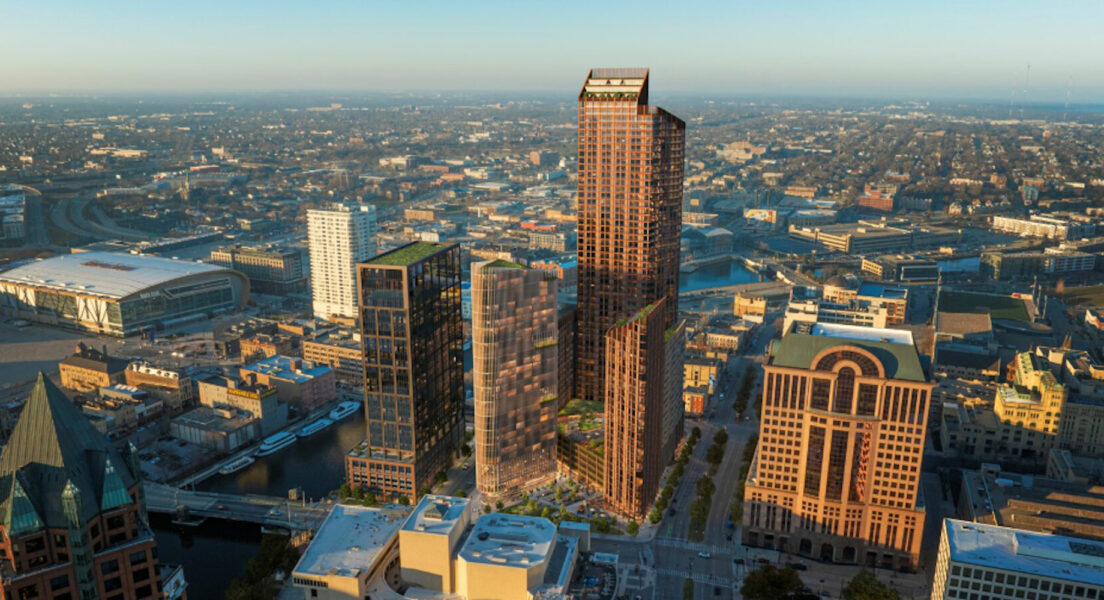Planned skyscraper to be 190 metres high

In Milwaukee, USA, a timber skyscraper with a height of 190 metres and 55 storeys is to be built. The project is considered a milestone for sustainable architecture and shows that wood can also play a key role as a building material in high-rise construction. With an investment volume of 700 million dollars, timber construction is setting new standards in the construction industry.
Just a few decades ago, it was unthinkable that timber buildings could be more than a few storeys high. But in recent years, advances in timber construction have opened up new possibilities. In Milwaukee, a ground-breaking project is on the horizon. A 190 metre high wooden skyscraper is to be built, setting a new world record in timber construction. The renowned architectural firm Michael Green Architects (MGA) from Vancouver has developed the plans for this visionary building, which is intended to impress not only with its height but also with its sustainable construction method.
Highly technologised solid wood
The wood used to build the skyscraper is much more than conventional timber. Glulam and cross-laminated timber, two main components of the project, consist of several glued layers of wood that offer exceptional strength and resistance. These materials can withstand moisture and extreme weather conditions and are also fireproof. In the event of fire, solid wood forms a protective carbon layer that stabilises the structure and prevents collapse.
Another advantage of solid wood is its environmental friendliness. As it grows, wood absorbs CO₂ and stores it. This property makes wood a climate-friendly building material that helps to significantly reduce the carbon footprint of a construction project. The use of prefabricated timber modules also speeds up the construction process, saving time and money.
A building that sets standards
The planned timber skyscraper in Milwaukee will not only be a record-breaking building, but also a symbol of the future of construction. In addition to the innovative timber construction method, the building will create a multifunctional centre comprising 750 residential units, 190,000 square metres of office space, 40,000 square metres of retail space and 300 hotel rooms. It is being built in the heart of the city, right next to the Marcus Performing Arts Centre, and is part of a comprehensive urban development initiative.
The project is also one of the largest and most ambitious in economic terms that Milwaukee has ever seen. With an investment of over 700 million dollars, it will have a lasting impact on the city’s skyline and create new jobs.
Challenges and potential
Despite the many advantages, the project will not be realised without challenges. Wood alone is not enough to fulfil all the structural requirements for a building of this height. It is likely that steel and concrete will be needed for reinforcement, similar to other projects of this size. Nevertheless, the project shows that timber in combination with other materials is a serious alternative in building construction.
A look at other projects illustrates the potential. In Switzerland, the 100 metre high “Rocket” is currently being planned in Winterthur, which is set to become the world’s tallest purely timber skyscraper. In contrast to the planned skyscraper in Milwaukee, the Rocket will use only wood, without any additional reinforcement in the form of steel or concrete. This shows that the use of wood as a load-bearing material in building construction is becoming increasingly important worldwide.
Future prospects for high-rise construction
The timber skyscraper in Milwaukee is being built in several phases in order to optimise the structure and meet the high safety requirements. The architects are using state-of-the-art techniques and materials to design the building efficiently and sustainably. The building is not only intended to set new standards for timber construction, but also to be a model for the future development of high-rise buildings worldwide.
The combination of sustainability and technological progress makes the planned timber skyscraper a milestone in the construction industry and a symbol of the architectural possibilities of the 21st century.